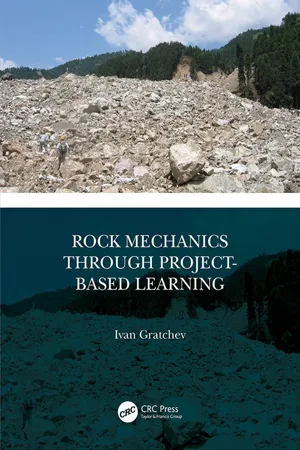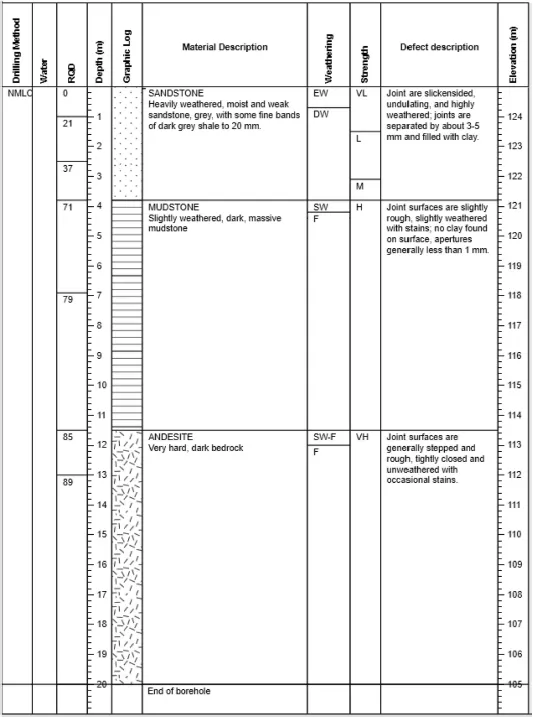
- 148 pages
- English
- ePUB (mobile friendly)
- Available on iOS & Android
Rock Mechanics Through Project-Based Learning
About This Book
Traditional textbooks on rock mechanics often fail to engage students in the learning process as such books are packed with theory that students are unlikely to use in their future employment. In contrast, this book delivers the fundamentals of rock mechanics using a more practical and engaging project-based approach which simulates what practitioners do in their real-life practice. This book will be of great help to those who would like to learn practical aspects of rock mechanics and better understand how to apply theory to solve real engineering problems.
This book covers geology, rock mechanics principles, and practical applications such as rock falls, slope stability analysis and engineering problems in tunnels. Throughout the whole book, the reader is engaged in project-based work so that the reader can experience what rock mechanics is like and clearly see why it is an important part of geotechnical engineering. The project utilizes real field and laboratory data while the relevant theory needed to execute the project is linked to each project task. In addition, each section of the book contains several exercises and quiz questions to scaffold learning. Some problems include open-ended questions to encourage the reader to exercise their judgement and develop practical skills. To foster the learning process, solutions to all questions are provided to allow for learning feedback.
Frequently asked questions
Information
Chapter 1
Introduction and book organization
1.1 Rocks and rock mechanics
1.2 Book organization
Chapter 2
Project description
2.1 Data from site investigation
2.2 Data from laboratory testing
2.3 Project tasks

- Analysis of geological conditions at the project site. This involves determining the major geological units, identifying geological structures and discussing their effect on rock properties (Chapters 3 and 4).
- Analysis of the borehole logs and drawing a cross-section along the A-A′ line. This involves describing the properties of each geological unit and identifying the rock layer(s) that may cause geotechnical issues. This part will be explained in Chapter 5.
- Analysis of joint characteristics of the rock mass and their effect of rock strength will be discussed in Chapter 6.
- Analysis of the lab data and determination of the engineering properties of intact rock specimens. This involves estimating the rock properties such as porosity, compressive and tensile strength, cohesion and friction angle. The laboratory procedures and data interpretation techniques will be discussed in Chapters 7 and 8.
 Figure 2.2 Borehole BH1, Elevation – 231 m. Borehole log legend: Drilling method: NMLC – diamond core 52 mm. Weathering: EW – extremely weathering, DW – distinctly weathering, SW – slightly weathering, F – fresh. Strength: VL – very low, L – low, M – medium, H – high, VH – very high.
Figure 2.2 Borehole BH1, Elevation – 231 m. Borehole log legend: Drilling method: NMLC – diamond core 52 mm. Weathering: EW – extremely weathering, DW – distinctly weathering, SW – slightly weathering, F – fresh. Strength: VL – very low, L – low, M – medium, H – high, VH – very high. Figure 2.3 Borehole BH2, Elevation – 200 m. Borehole log legend: Drilling method: NMLC – diamond core 52 mm. Weathering: EW – extremely weathering, DW – distinctly weathering, SW – slightly weathering, F – fresh. Strength: VL – very low, L – low, M – medium, H – high, VH – very high.
Figure 2.3 Borehole BH2, Elevation – 200 m. Borehole log legend: Drilling method: NMLC – diamond core 52 mm. Weathering: EW – extremely weathering, DW – distinctly weathering, SW – slightly weathering, F – fresh. Strength: VL – very low, L – low, M – medium, H – high, VH – very high. Figure 2.4 Bore...
Figure 2.4 Bore...
Table of contents
- Cover
- Half Title
- Title
- Copyright
- Contents
- Preface
- Conversion factors
- About the author
- 1 Introduction and book organization
- 2 Project description
- 3 Rock mass formation
- 4 Rocks and rock minerals
- 5 Rock exploration
- 6 Discontinuities in rock mass
- 7 Rock properties and laboratory data analysis
- 8 Stresses and failure criteria
- 9 Rock mass ratings and properties
- 10 Rock falls
- 11 Rock slope stability
- 12 Rocks and tunnels
- References
- Index